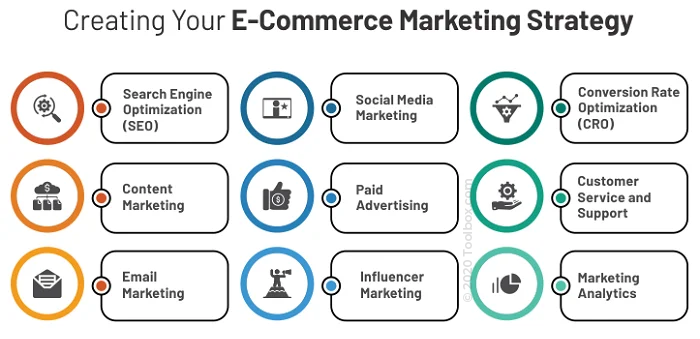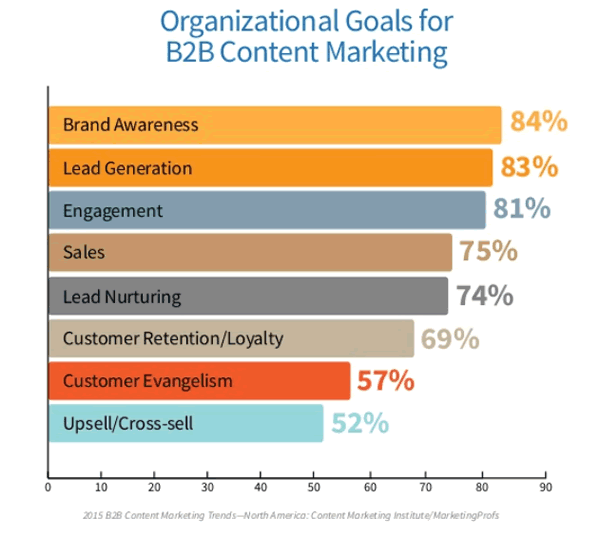8 Ways to Get the Most Out of Your E-commerce Marketing Strategy

Table of Contents
- What is an E-commerce Marketing Strategy?
- 8 Tips to Get the Most Out of Your E-commerce Marketing Strategy
- Key Takeaways
- Conclusion
- FAQS
E-commerce has changed dramatically since the first Internet sale in 1994. Online buying has forever changed the retail environment thanks to social networking, information accessibility, and digital marketing. It is crucial to have an airtight e-commerce marketing strategy to survive and sustain your e-commerce business in today’s online world.
In this blog, we will deep dive into what an e-commerce marketing strategy is and some of the best e-commerce marketing tactics.

What is an E-commerce Marketing Strategy?
The process of attracting traffic to your business, converting that traffic into sales, and increasing brand visibility is e-commerce marketing.
E-commerce marketing concepts change constantly with the industry and audiences. So, it is important to plan well to maintain the highest ROI rates. Half the battle is won when you choose the right strategy and customize it to get the outcomes you want.
An e-commerce marketing strategy is a 360-degree plan composed of both on- and off-site marketing strategies. A well-thought-out marketing strategy can help you raise brand awareness, develop client loyalty, and boost online sales.
You can use various models to set up your e-commerce marketing strategy. Take, for example, the 4Ps model (product, price, place, and promotion). These are the most critical factors in marketing a product or service, and they interact heavily. Considering all these factors and tying them together is one promising approach to build your strategy.

8 Tips to Get the Most Out of Your E-commerce Marketing Strategy
Now that we understand what an e-commerce marketing strategy entails, let’s make it easier for you to build an airtight strategy that gets you excellent results. Here are some of our best tips.
1. Identify your marketing goals
The first step to building an effective strategy is identifying the right marketing goals for your business.
Goal-setters were 376 percent more likely to experience good outcomes, according to a survey of over 3,000 marketers. Setting the right marketing goals allows you to steer your company on the proper path and make decisions that are always in the best interests of your organization.

The right goals can also help you improve the efficiency of your company. Your team will perform as a cohesive unit, structured toward a defined purpose if all employees are linked to the same, specific goals.
2. Understand your target audience
Target audiences can be rapidly established at a high level. People that desire to arrange their accounts to run their enterprises more efficiently, for example, could be the target audience for an accounting software company. This is a decent place to start when developing marketing and sales messaging.
However, for in-depth marketing, a more specific strategy to target audiences is required.
As per the Marketo Engagement Gap research, 56% of customers say organizations need to understand their needs better.
According to the report, it’s astonishing how frustrated individuals can become when they’re part of a target demographic for social networking sites and the product or service isn’t relevant to them or when the corporation talks more about themselves than being customer-centric.
3. Produce original content
This one is a no-brainer. Content is key when it comes to marketing. Publishing high-quality, original content will help you succeed because it resonates well with your audience and encourages them to interact, buy from you, and follow you.
Be inventive. Be unique in your approach.
Good, original content is an excellent method to make a statement, convey a captivating idea, and leave a lasting impression on the user. The difference between content that engages users and repels them is razor-thin. Make sure you’re on the right side.
4. Optimize your website for a better UX
Have you ever visited a website intending to buy something but found the interface so poor that you ended up not buying it? You’re not alone. As per a study by Kinsta, more than 70% of online shoppers abandon their carts because of poor UX.
Grasping what your users might want to see and access, as well as what you have to give, is the foundation of good UX. Make things as frictionless as possible for the user, mainly because human attention spans are dwindling by the day. Cart abandonment, fewer return visitors, and a lousy reputation through word-of-mouth will result from too many stages or a complex checkout procedure.
5. Leverage social media channels
A well-managed social media presence is essential for any well-built e-commerce marketing strategy. However, e-commerce marketing via social media may not appear the same as marketing for a traditional business. Not all social media platforms are suitable for e-commerce.
E-commerce is a visual medium by nature. Only a tiny percentage of customers are interested in buying a product merely based on its description. The use of graphics and videos to draw attention and drive traffic to your website is critical.

If possible, include shoppable content in your e-commerce marketing campaign -interactive material that enables visitors to purchase a click. This might range from strategically inserting display adverts within a social feed to adding more content.
6. Use the best SEO practices
Making sure an e-commerce website is optimized for search engines is one of the most crucial and time-consuming strategies for improving it. With today’s SEO standards, it’s more critical than ever to keep your website updated with fresh, relevant information, create a positive user experience (UX), and be as error-free as possible.
Your website’s content should be rich, trustworthy, and provide the public with valuable and relevant information.
When customers seek something specific, including keywords in your content legitimately can rank your website as a top result on search engines. SEO is one of the most cost-effective and high-return e-commerce marketing tactics available.
7. Explore pay-per-click advertising
According to a study by Clutch, 45% of small firms use pay-per-click (PPC) advertising. 74% of small businesses with more than 50 employees spend money on PPC advertising.
It doesn’t matter what your budget is. PPC advertising is highly cost-effective and brings your audience to your website. As the name implies, you only pay the publisher when your ad is clicked on. Bidding determines ad rates, allowing you to be more flexible with your marketing budget. Unlike many other marketing tactics, PPC makes it simple to contact and engage your target audience.
8. Retarget warm audience and customers
If you are not retargeting your audience, you lose a significant chunk of revenue. Retargeting is a particular sort of online advertising that focuses on visitors who have left a website without converting.
Consider this scenario: a customer has expressed interest in a product and still has your e-commerce app installed on their device, but they haven’t completed a purchase in over a month, according to your mobile analytics. To urge this customer to return to your app and complete the transaction, you can retarget them with a special offer or promotional approach.
While retargeting doesn’t guarantee conversions, it does assist in keeping your brand top-of-mind, encouraging consumers to convert when they’re already near.
These e-commerce marketing tactics will help you notch up your e-commerce marketing strategy.
Key Takeaways
- An e-commerce marketing strategy is a 360-degree plan composed of both on- and off-site marketing strategies. A well-thought-out marketing strategy can help you raise brand awareness, develop client loyalty, and boost online sales.
- The first step to building an effective strategy is identifying the right marketing goals for your business.
- Understanding your target audience’s needs, wants, and desires at a deep level is very important for an effective strategy.
- Content is key when it comes to marketing. Publishing high-quality, original content will help you succeed because it resonates well with your audience and encourages them to interact, buy from you, and follow you.
- A good UX is critical to prevent the audience from dropping out and hence should be prioritized in your strategy.
- Social media presence can help you heaps and bounds when raising brand awareness and connecting with your audience.
- Content optimized for search engines can help you rank better for relevant search queries and improve website traffic.
- PPC advertising is an excellent e-commerce marketing tactic to get good results.
- Retargeting warm audiences and customers can help you drive a lot of revenue.
Conclusion
If your company has an e-commerce presence, you can benefit significantly from experimenting with and implementing various e-commerce marketing methods. Many of the solutions offered are both cost-effective and beneficial.
Make sure your e-commerce marketing strategy is dynamic, varied, and well-maintained, no matter how you arrange it. Putting one of these strategies into action will take some time and effort, but it will pay off handsomely if executed well.
FAQs
An e-commerce marketing strategy is a 360-degree plan composed of both on- and off-site marketing strategies. A well-thought-out marketing strategy can help you raise brand awareness, develop client loyalty, and boost online sales.
An example of e-commerce marketing is any brand or business selling a product/ service on an online platform.
There are many types of e-commerce marketing, and you should explore a good mix of all. Some of these include
1. Pay-per-click advertising (PPC)
2. Search Engine Optimization (SEO)
3. Web push marketing
4. Social media marketing (SMM)
5. Chatbot marketing
6. Influencer marketing
7. Affiliate marketing
8. Email marketing
Latest Blogs
Explore how Google’s 2025 AI search updates triggered ranking chaos. Learn actionable strategies to adapt your SEO for AI Overviews, zero-click searches, and SERP volatility. Stay ahead now.
Learn how to rank on AI search engines like ChatGPT, Perplexity, and Gemini by optimizing your content for authority, structure, and relevance. Stay ahead in AI-driven search with this strategic guide.
Explore the best healthcare SEO services for your medical practice. Improve online visibility and effectively reach more patients in need of your services.
Get your hands on the latest news!
Similar Posts

Content Marketing
4 mins read
11 Best B2B Content Marketing Agencies for B2B Companies in 2024

Content Marketing
5 mins read
Top ecommerce Marketing Agencies with Proven Strategies for 2024

Content Marketing
5 mins read